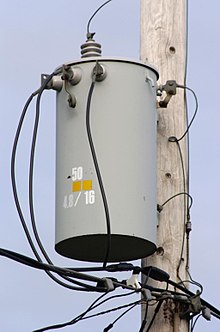
Back Transformador de distribución Spanish ترانسفورماتور توزیع Persian Jakelumuuntaja Finnish वितरण ट्रांसफॉर्मर Hindi 柱上変圧器 Japanese Transformator rozdzielczy Polish

A distribution transformer or service transformer provides a final voltage transformation in the electric power distribution system, stepping down the voltage used in the distribution lines to the level used by the customer.[1] The invention of a practical, efficient transformer made AC power distribution feasible; a system using distribution transformers was demonstrated as early as 1882.[2]
If mounted on a utility pole, they are called pole-mount transformers. Suppose the distribution lines are located at ground level or underground. In that case, distribution transformers are mounted on concrete pads and locked in steel cases, thus known as distribution tap pad-mount transformers.
Distribution transformers typically have ratings less than 200 kVA,[3] although some national standards allow units up to 5000 kVA to be described as distribution transformers. Since distribution transformers are energized 24 hours a day (even when they don't carry any load), reducing iron losses is vital in their design. They usually don't operate at full load, so they are designed to have maximum efficiency at lower loads. To have better efficiency, voltage regulation in these transformers should be kept to a minimum. Hence, they are designed to have small leakage reactance.[4]
- ^ Harlow 2012, p. 3-4.
- ^ "Lightcast". Lightcast. Retrieved 2024-09-11.
- ^ Bakshi 2009, p. 1-24.
- ^ Bakshi 2009, p. 1-25.